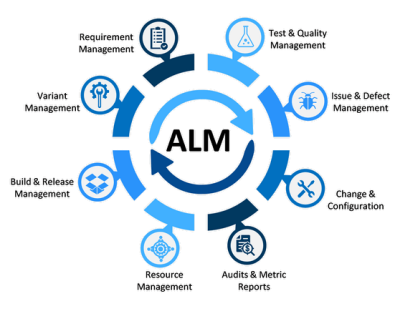
Get the report
MoreApplication lifecycle management (ALM) encompasses all aspects of the application lifecycle, especially the usage, maintenance and servicing of the application after it has already been developed.
Application lifecycle management software tools help to provide visibility and transparency while promoting communication and collaboration throughout the application lifecycle.
The process of application lifecycle management begins when an organization decides to invest time and money into solving a problem by building software and continues until the application is no longer in use. A structured framework for managing the application throughout its lifecycle helps organizations in the following ways:

The increasing popularity of the agile manifesto and Agile software development has fundamentally changed how many software development teams and IT organizations manage the application life cycle. Agile methodology has in many ways replaced the older, now somewhat outdated Waterfall methodology for planning, developing and servicing new software applications.
In the Waterfall method, the software development process is divided into distinct phases that are meant to be completed sequentially without going backward. Each phase is completed exactly one time and the outputs from each phase act as the inputs for the next phase. A project in a Waterfall project may begin with a business analysis of requirements before progressing to project design, development, and through the additional steps necessary to produce the application. Each phase of the project will most likely be completed by a designated working group with expertise in that area.
In the Agile method, developers take an incremental approach to software development that is more flexible. Activities like developing requirements, designing and architecting code and programming may be visited and revisited several times throughout the development process. The agile manifesto encourages organizations to create integrated project delivery teams that collaborate on each phase of project delivery, rather than having siloed teams for each phase of the project.
Project teams will have different approaches to application lifecycle management depending on the working methods and frameworks used to organize the software development and ALM processes.
Application lifecycle management incorporates three closely connected aspects of management: governance, development, and operations. Each component plays a different role in effectively directing activities around the application throughout its life cycle and ensuring that the organization is adequately positioned to create and derive value from its investments in technology.
Application governance
Governance describes the processes and activities used by the organization to exercise decision-making control over applications that are being developed. The purpose of application governance is to ensure that the application consistently meets the needs of the business. Effective governance depends on a clear and efficient structure for decision-making, and on placing the right people in the right roles to make the best decisions about the application and its development and operation. Organizations must also ensure adequate transparency and flow of information such that project managers can make the most informed decisions to direct the lifecycle of the application.
Application development
Application development includes the gathering and analysis of user requirements, the development, and testing of new code, building and testing new releases and the deployment of the application into the production environment. While application governance lasts for the entire application lifecycle, the application development process is not always active. Most application development may take place prior to the initial deployment, with additional development activities taking place post-deployment in response to changing user needs.
Application operations
Application lifecycle management includes the operation of an application that has already been developed and deployed by the organization. Applications operations include the monitoring and performance measurement of applications in production, development, and implementation of appropriate monitoring tools, providing development teams with access to performance data, configuring application infrastructure, and coordinating the response to application issues such as performance faults or degradation. Application operations begin once an application has been deployed and continues through to the end of the application life cycle.
Each of the core aspects of application lifecycle management is supported by a set of processes and activities. Application governance, development and operations all include a range of tasks that must be executed by members of the organization throughout the application life cycle.
Governance activities
Development activities
Operations activities
Once an application has been deployed, IT operations analysts take on the responsibility of implementing and configuring a monitoring tool to ensure that the application meets the performance and usability requirements of customers and the business.
For organizations that host applications in the cloud, Sumo Logic's cloud-native platform is the ideal solution for monitoring cloud applications. Sumo Logic provides security, operational and business analytics that helps secure your public cloud data assets while driving performance excellence and business success.
Reduce downtime and move from reactive to proactive monitoring.